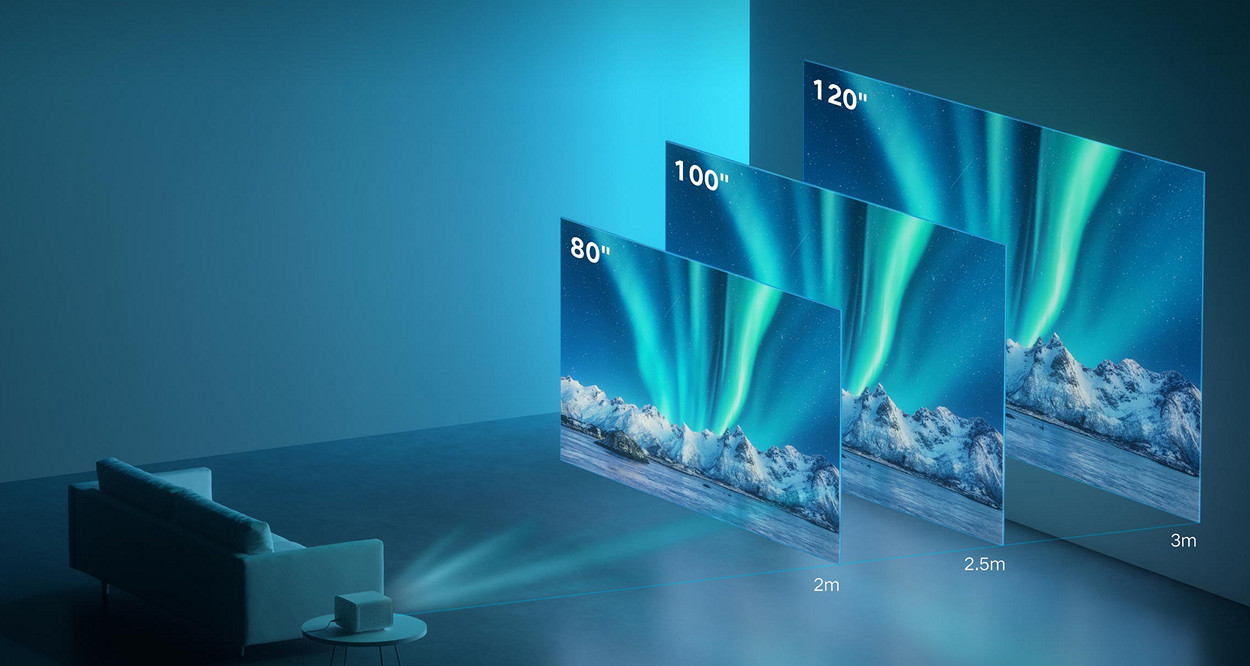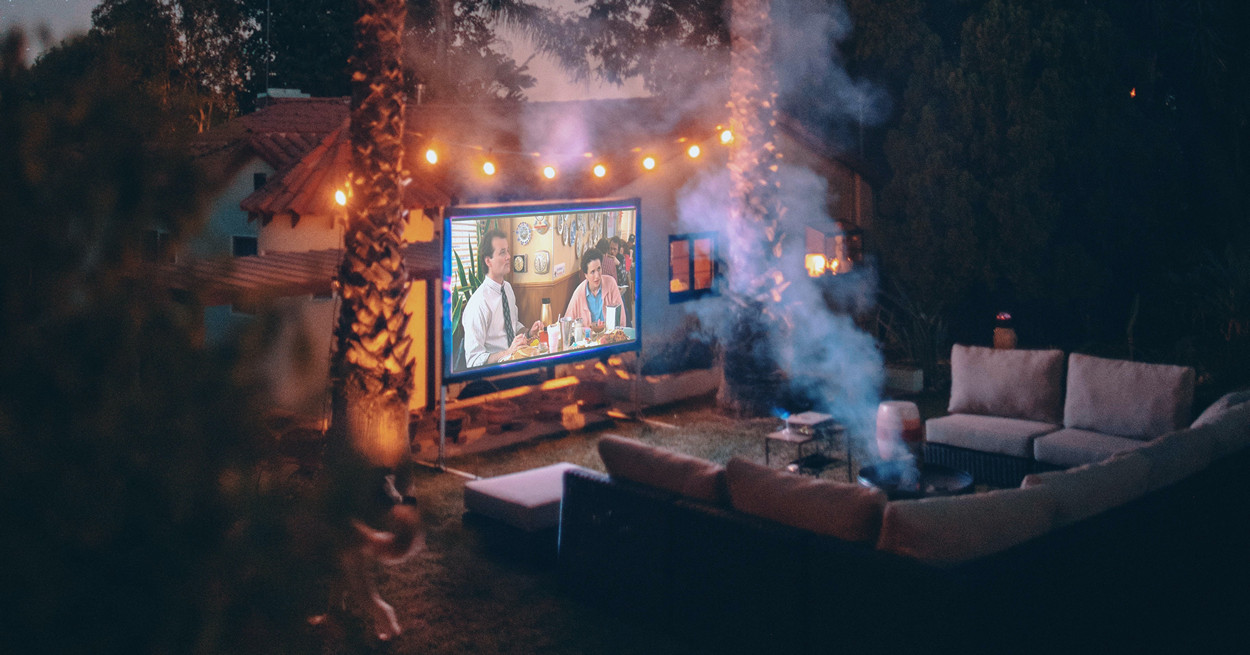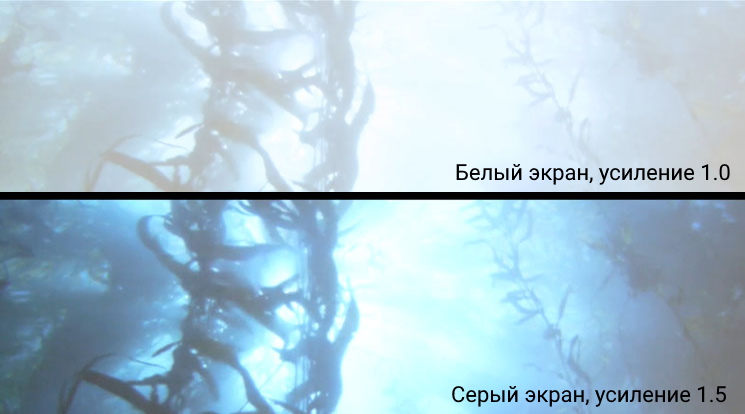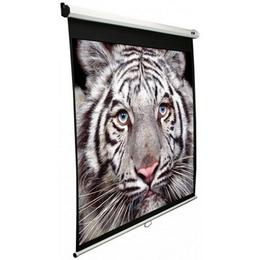
</ img>
Photo: Xiaomi
A projector is not a stand-alone device; it must work in tandem with a projection screen, the choice
Screen size and aspect ratio
The first and most obvious parameter for the screenis, of course, its diagonal. When choosing a projector and a screen, there are three things that need to be matched with each other: screen size, projector throw ratio, and installation location.
If these parameters are taken into account, after purchasing the equipment you will not receive unpleasant surprises, such as a picture extending beyond the screen or lack of proper focus.
Do not forget about the same ratiosides for screen and projector: the current standard for high-definition multimedia is 16:9. The 4:3 aspect ratio is still popular in devices used for presentations in offices or for educational purposes, but for home theater this ratio is not as interesting due to the large unused margins. Which will definitely appear when watching modern films, clips and other content with an aspect ratio of 16:9.
There is also the popular 16 format:10, which corresponds to resolutions of 1920 × 1200 and 1280 × 800 - this format allows you to view 1080p video with small inactive margins on the screen, but also has additional space for more comfortable viewing of presentation slides.

</ img>
For watching movies, there is also a screen ratio standard called Cinemascope, which corresponds to 2.39: 1. This format is used in public cinemas.
Design
By the type of construction, screens can be divided into two main groups: stationary and mobile.
Stationary
On the frame- this design involves assembling the frame withBy subsequently stretching the canvas over it, the assembled structure is fixed to the wall. The main advantage of this type of screen is the uniform tension of the canvas, which eliminates the appearance of distortions.
Roll-up roll-up screencan be mounted on the ceiling or be wall-mounted. Such screens are compact and allow you to deploy them on top of a TV that can hang on the wall, thereby turning an ordinary living room into a cinema room.
A weighted tape is used for tension,which is sewn to the bottom of the screen, which causes imperfect tension. More expensive models can also use side tensioners to solve this problem.
Unfolding roll-up screens cancarried out manually or be motorized by an electric drive. Some models of projectors have a special trigger output that gives a signal to open the screen when the projector is turned on.
Wall projectionis also a fairly common and inexpensive screen option. Here it is important to determine in advance exactly the location of the future screen, because it will no longer be possible to move it.

</ img>
Photo: Roberto Nickson
Mobile screens
Mobile screens can represent the samea roll-up screen that mounts on a special tripod and folds down for transportation. Such a screen is perfect for road presentations, and for moving between different rooms within the same office or educational institution.
On a collapsible frame, due to its design, such a screen hasbetter blade tension and better stability, which allows you to work comfortably with large blade sizes. For transportation, such screens are folded into a special case.
Inflatable screen- a type of design for use in open street areas, similar to an inflatable children's trampoline.
Inflatable transport frame folds downinto a bag, installed and maintained in working shape with the help of fans that blow air and maintain pressure even if the shell is damaged.
Gain
Gain is a characteristicindicating the reflectivity of the projection screen cover. It shows how much more or less light the screen will return in comparison with a white matte canvas, which is also called "Lambert". The coefficient of such a canvas is 1.0, it scatters light evenly in all directions. If the ratio is 1.3, then the screen will return 30% more light towards the viewer. With a value of 0.8, only 80% will return, the rest will absorb the screen surface.
It would seem that the higher the gain,the better, because you can compensate for the insufficient brightness of the device. However, not all so simple. Firstly, the higher the screen gain, the narrower the viewing angles of such a screen - when looking at such a screen from the side, its brightness noticeably drops. This will interfere with comfortable viewing for a large group in rooms where there are not several rows of seats. Secondly, as the reflective power of the screen increases, glare and brighter areas - so-called “hot spots” - may appear on it (when viewed from certain angles).

</ img>
Photo: Elite Screens
For screens with a coefficient less than 1.0 also has its strengths and weaknesses. The main advantage is the increased image contrast and deeper dark colors. The disadvantages include the fact that to work with such a screen, you need a sufficient margin of projector brightness: do not forget that when using 3D glasses, the brightness of the image will decrease even more.
Viewing angle
Viewing angles are by no means a new concept. Probably everyone knows what this is, largely thanks to LCD screens; by analogy with them, projection screens also have this parameter.

</ img>
Photo: Panasonic
If you are planning to buy yourself a regular matte screen, don't worry about it - its viewing angles are very wide.
But if you need a screen with increased gainor ALR technology, you should pay attention to the “half gain angle” parameter, which characterizes the boundaries of comfortable viewing in degrees. The viewing point with maximum brightness is perpendicular to the center of the screen; if the viewer moves away from the center of the screen, the brightness will gradually decrease. At the half-gain point, the brightness is 50% of the peak value.
Types of coatings
White screens
Matte white screen - the foundation of allscreens, the most versatile and widespread solution. This type of screen is perfect for home theaters in rooms with adjustable lighting levels. They have a wide viewing angle.
Elite Screens M136XWS1
Roll-up projection screen Elite ScreensMaxWhite is wall-mounted and can be folded down easily so it doesn't disturb the interior of the room. MaxWhite 1.1 gain white material provides maximum viewing angles for 4K movies.
M Video
Techport
Svyaznoy

</ img>
But, of course, everything has its drawbacks.For a white matte screen, this disadvantage is its diffuseness; it will reflect light in all directions not only from the projector, but also from any other light source. Including the reflected one, which falls on the white ceiling and walls of the room, and then back onto the screen. This reduces the contrast of the image. To combat this effect, you need to exclude third-party light sources and light interior details as much as possible. And if the first is easily doable at home, then problems may arise with the second. And here the following type of coverage can help us.
Gray screens
Gray screen is a relatively new type of screen,which comes from the aforementioned white. The color of such a screen can be in several shades of light gray. Grayscale screens can have a gain below or above 1.0. The darker screen color reduces the amount of ghosting, resulting in deeper blacks and better contrast, but there may be slight loss in the display of light tones.
ALR screens
ALR or Ambient Light Rejecting, which translatesas “ambient light reflection” is the general name for screens that reflect or absorb light from lamps, windows and other sources, thereby increasing the contrast and brightness of the picture in bright rooms.
When people talk about an ALR screen, it usually hasI mean it's a mirror reflection screen. Unlike a conventional projection screen, which scatters light in all directions, they work on the basic law of optics: the angle of incidence is equal to the angle of reflection. The projector is installed in front of the screen so that the screen reflects the light of the projector directly to the viewer. In this case, light from third-party sources is reflected towards the viewer according to the same principle. It is important that such sources are not in the same direction as the projector itself, otherwise unwanted light will still enter the viewing area.
Another type of ALR screens, more expensive andrare is reflective, which reflects light from the projector to the audience but absorbs unwanted light. The surface of such a screen is made in the form of microscopic triangular lenses. These lenses are located horizontally on the screen, which means that such a screen will absorb overhead light most efficiently.
Screens for UST Projectors
UST - special screens designed forwork with ultra-short-throw projectors, which are installed at a distance of several tens of centimeters from the screen. This type of projector is becoming more and more popular and is likely to supplant classic telephoto projectors in the consumer market over time.
Screens like ALR are designed in such a wayso as to absorb the stray light and display the best possible picture, regardless of ambient light. The surface of UST screens consists of miniature triangular prisms. From below, a beam of light falls on them from a searchlight, which is clearly visible to the viewer. If the light is on in the room, then falling on the screen from above is absorbed by the opposite side of the triangular prisms:

</ img>
The coating of the working side of the prism can be white or gray, with different amplification factors. The upper part that absorbs background light is black.
A big plus of these screens is the wide viewing angles.
Black screens
Another type of ALR screen is a "sandwich"from several optical layers. Light passes through them and, reflecting from the lower with a high level of reflection, returns back through all layers to the viewer. At the same time, such a screen absorbs all the scattered light that can fall on it from above, below and from the sides, which gives a very high level of contrast even in a lit room.
With this screen you can achieve the effectwatching a movie in a dark room. The screen absorbs re-reflected light from a light ceiling or walls, and this light no longer affects the picture or reduces its contrast.
Black screen against white
But for all good things you have to pay, in this case with viewing angles - on such screens they are at the level of 30-35°.
Rear projection screen
You can direct a beam of light onto the screen not only from the front, but also from the back. This method is called back projection.
The advantages of this type of projection are that there is a higher level of contrast, and the person in front of the screen does not block part of the image.
The main disadvantage of this projection is thatthat a fairly large room is needed to install the equipment. The projector must be located behind the screen at a certain distance, and, of course, the space between it and the viewing area will be “useless” - you cannot walk there so as not to cast a shadow.
Beyond projection screens for rear projectionspecial transparent and opaque films are used, paint for rear projection, but these are, rather, options for specific professional use. For example, to decorate shop windows.
Acoustically transparent screens
When arranging a high-quality homecinema for the correct perception of films, it is very important to place the front speakers just behind the screen. In order for the sound to reach the viewer with practically no loss, acoustically transparent screens are used, this can be perforated or woven fabric.

</ img>
Photo: Elite Screens
The woven fabric of the screen transmits sound better, especially in the upper range, but such a fabric can only be matte white.
A perforated canvas is more prone to sound interference between it and the wall on which the speakers are located, but such canvases can be not only white, but also gray or black with ALR.
Painted wall
Painting a wall is quite inexpensive anda common option. But for this it is not enough just to paint the wallpaper on the walls with white paint. To avoid distortion, the wall must first be plastered and puttyed so that the surface becomes as even and smooth as possible. Only after this can the wall be primed and painted with several layers of paint. The paint for this needs to be matte and neutral in color so as not to harm the white balance.
If the alignment of the walls for any reasonis impossible, flat, large-area building materials, for example, sheets of plasterboard or chipboard, can be considered as options. They can be mounted on the wall with subsequent processing and painting.
Mainly for painting walls for projectionThe screen uses specialized paints that are developed for these purposes and are guaranteed to give an excellent result if the painting technology is followed. Such paints can be of different colors: white, gray, silver - to suit any customer’s requirements.

</ img>
Photo: Elvis Ripley
Sometimes it is possible to choose a suitable option andamong “ordinary” paints. In our latitudes, Tikkurilla Harmony H499 is especially popular, as it gives a predictable result, unlike cheaper analogues, and costs relatively little (when compared with specialized paints for screens).
When creating a screen with your own hands, you should not forgetabout gluing a frame of black matte tape, such as velvet, around the screen. Such a detail will not only visually separate the screen from the rest of the wall and hide the transition, which in some places may not be ideal, but will also give the image additional visual contrast.
Answers to frequently asked questions
Do I need a dedicated screen for 3D display?
No, for 3D at homeno special screen needed. But since the image brightness is noticeably reduced when viewed with 3D glasses, it is worth making sure that your projector is bright enough when choosing between a white or gray screen.
What color should I choose for my home theater screen?
The choice of the screen color depends on the illumination duringworking hours. If the lighting is completely controlled, and the interior in the room is not too light, then you can safely choose a white screen. If a small background illumination or reflective light is supposed, a gray screen will suit you. Black screens are not afraid of third-party lighting and provide excellent contrast, but the high cost of such high-tech screens plays an important role here.
Which screen is best for 4K video?
Ultra HD content requires a high screenquality. It should be uniform and smooth so as not to distort the display of pixels of a small enough size. Screen manufacturers label such sleek models as "4K screen" (or UHD / Ultra HD). If you are on a tight budget for a 4K projector screen, consider getting a good quality matte wall paint job rather than just buying a budget vinyl screen.